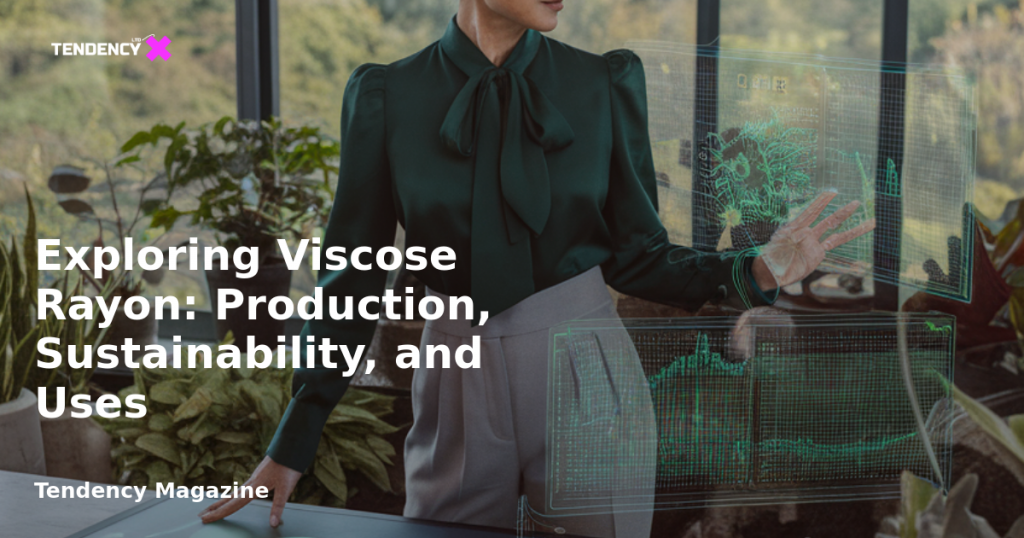Exploring Viscose Rayon: Production, Sustainability, and Uses

What is Viscose?
Viscose is both a fiber and a fabric derived from plant-based cellulose, a complex carbohydrate that provides structure to plant cell walls. Common sources of cellulose include natural wood pulp from eucalyptus, pine, or beech, as well as bamboo. Viscose fibers are the foundation of fabrics such as modal, rayon, lyocell, acetate, and cupro. The fabric itself, often referred to as artificial silk, boasts a smooth texture and soft sheen.
Despite being made from natural materials, viscose is a semi-synthetic fiber. Unlike purely natural fibers like wool and cotton, which are processed without chemical modification, viscose rayon requires extensive chemical processing to extract cellulose from natural wood pulp.
Open-loop vs. Closed-loop Viscose Production
There are two primary methods for producing viscose rayon: open-loop and closed-loop. While both achieve similar results, they differ significantly in terms of sustainability.
Open-loop Production
Dating back to the early 20th century, open-loop production was used to create the first commercially available viscose fabrics. This process involves harsh chemicals like carbon disulfide and sodium hydroxide to extract and refine cellulose fibers, leading to potential pollution and health hazards.
Closed-loop Production
Closed-loop production is a modern technique that minimizes waste by reclaiming materials post-manufacturing. With proper execution, this method can capture and reuse up to 95% of the chemicals used. Modal rayon and lyocell are examples of fibers produced using closed-loop processes, which are generally more advanced and costly.
Understanding the Viscose Production Process
The viscose manufacturing process involves several steps, including extracting, dissolving, spinning, and finishing.
1. Extracting
Manufacturers start by breaking down raw materials, such as trees or bamboo, into chips and processing them with water and chemicals to produce wood pulp. This step separates cellulose from other plant materials.
2. Dissolving
In closed-loop production, wood pulp is combined with a non-toxic solvent, N-Methylmorpholine N-oxide (NMMO), to break down the cellulose fibers. Open-loop processing involves treating pressed sheets with sodium hydroxide and carbon disulfide to form a viscose solution.
3. Spinning
The viscose solution is then passed through a spinneret, creating regenerated cellulose fibers. Open-loop production uses a chemical bath to solidify these fibers, while closed-loop processing employs a water bath or air chamber.
4. Finishing
Rayon filaments are washed, bleached, dyed, and spun into yarn or fabric. Closed-loop production treats excess liquid to reclaim chemicals for future use.
Is Viscose Sustainable?
The sustainability of viscose depends on the production process and sourcing decisions. Evaluating sustainability involves considering the entire production process, from raw material to final product, including material origin, production efficiency, and waste.
Some viscose production is linked to deforestation, reducing biodiversity and threatening native animal populations. Sustainable viscose production involves sourcing materials from FSC-certified (Forest Stewardship Council) sources, indicating responsible growth and harvest.
Closed-loop processing reduces waste by reusing chemicals, whereas open-loop sites generate significant chemical and water waste, potentially causing environmental harm. Sustainable viscose is more environmentally friendly than conventionally grown cotton, which is water-intensive and uses harmful pesticides, although conventional cotton is more sustainable than open-loop viscose.
Viscose fibers are also biodegradable, decomposing naturally without contaminating soil, although they do not biodegrade in landfills.
Advantages of Using Viscose Rayon
Viscose offers a balance between synthetic and natural fabrics, making it popular among fashion designers and consumers for several reasons:
– Affordable: Rayon fabrics are less expensive than natural materials, helping brands maintain affordability and strong profit margins.
– Versatile: Viscose rayon fabrics can have a light sheen or matte finish, suitable for formal dresses or structured blazers.
– Comfortable: Soft and breathable, viscose fibers have moisture-wicking properties that keep wearers comfortable in warm environments.
– Absorbs Dye: Viscose fibers are hydrophilic, absorbing dye effectively for vibrant colors.
– Drapes Well: Viscose fabrics drape beautifully, ideal for flowing garments like dresses and skirts.
– More Sustainable than Synthetics: When produced sustainably, viscose is more eco-friendly than synthetic materials like polyester.
Disadvantages of Using Viscose Rayon
For those prioritizing longevity and sustainable production, viscose may not be the best material:
– Lacks Durability: Rayon fibers snag easily and may pill with frequent wear.
– Prone to Water Damage: Certain viscose fabrics can suffer aesthetic and structural damage from water.
– Difficult Care: Viscose wrinkles easily and often requires dry cleaning or hand-washing.
– Environmental Concerns: Traditional viscose production generates significant chemical waste and is linked to deforestation due to unethical sourcing practices.
Viscose Fabric FAQ
What is viscose fabric?
Viscose is a semi-synthetic fabric with a smooth surface and light sheen, often used as a low-cost alternative to natural silk.
Is viscose a good quality fabric?
Viscose quality varies based on production processes. High-quality viscose is made from high-grade wood pulp and durable fibers.
What are the disadvantages of viscose fabric?
Viscose is prone to snags and requires delicate laundering. Its production process is resource-intensive and sometimes involves toxic chemicals.
Is viscose better than cotton?
Viscose is affordable and versatile, while cotton is durable and machine-washable. The best material depends on specific needs.
Is viscose good for summer?
Yes, viscose is lightweight and breathable, making it suitable for warm weather due to its moisture-wicking properties.
Conclusion
Viscose rayon continues to be a popular choice in the textile industry due to its affordability, versatility, and comfort. However, its environmental impact depends significantly on the production methods and sourcing practices. As the demand for sustainable materials grows, closed-loop production and responsibly sourced viscose offer promising solutions for producing eco-friendly fabrics. By understanding the advantages and disadvantages of viscose, brands can make informed decisions about incorporating this material into their product lines.
2025 Tendency LTD. All rights reserved.

